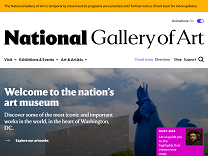The Return by Thomas Cole https://www.nga.gov/artworks/166438-return
Thomas Cole turns the landscape into a backdrop for a medieval tale in The Return , one of a pair of luminous paintings set at sunrise and sunset. Cole drew on several sources, including Scottish historian and poet Sir Walter Scott’s popular verses about warfare between the English and the Scots.
On a dirt path across the front of the picture, an armored man is carried on a red

